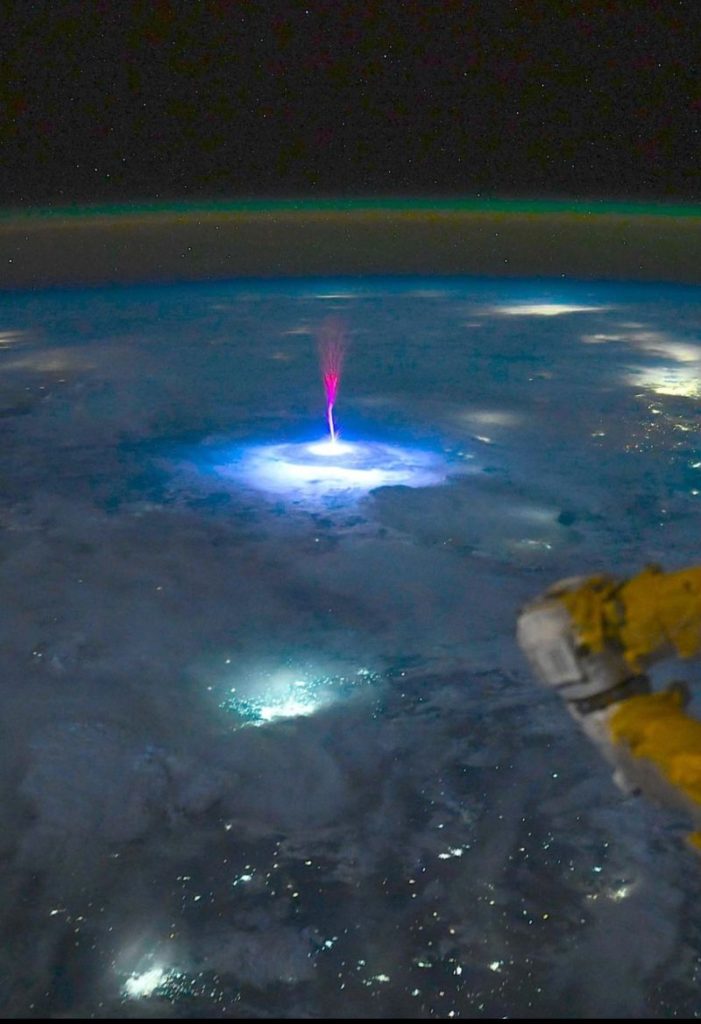Transient Luminous Events (TLEs): Earth’s Upper-Atmospheric Light Shows

This is a sprite, a Transient Luminous Event (TLE), snapped by NASA’s Astronaut Nichole Ayers from the International Space Station.
Transient Luminous Events (TLEs) are extraordinary electrical phenomena occurring high above thunderstorms, forming a family of fleeting, colorful light displays in the upper atmosphere. Unlike tropospheric lightning, TLEs manifest as luminous plasma discharges triggered by intense lightning below, illuminating the mesosphere, ionosphere, and stratosphere. Here’s a comprehensive exploration:
⚡ 1. What Are TLEs?
- TLEs are brief (milliseconds to seconds) electrical breakdowns occurring 20–100+ km above thunderstorms, far higher than normal lightning (which peaks at ~15 km) .
- They are secondary phenomena induced by intense lightning discharges, particularly positive cloud-to-ground strikes that create powerful electromagnetic pulses (EMPs) .
- First documented photographically in 1989, TLEs were long dismissed as pilot folklore until scientific verification .
🔮 2. Types of TLEs and Their Characteristics
TLEs exhibit diverse forms, often named after mythical creatures due to their elusive nature:
Table: Major Types of Transient Luminous Events
| Type | Altitude Range | Color | Duration | Key Features | Trigger |
|---|---|---|---|---|---|
| Sprites | 50–90 km | Red/orange, blue | <50 ms | Jellyfish/carrot shapes with tendrils; most common TLE | Positive cloud-to-ground lightning |
| Blue Jets | 20–50 km | Intense blue | 200–300 ms | Conical jets from cloud tops; faster than sprites | Intracloud lightning discharge |
| Gigantic Jets | 40–90 km | Blue (base), red (top) | ~300 ms | Connects clouds to ionosphere; rare | Negative leader escaping cloud |
| ELVES | ~100 km | Red/diffuse | <1 ms | Expanding rings (up to 400 km wide); fastest TLE | EMP from lightning |
| Sprite Halos | 70–85 km | Red/pink | <1 ms | Diffuse disks preceding sprites | Same as sprites |
| Blue Starters | <20 km | Blue | Brief | “Failed” blue jets; shorter and brighter | Unknown, linked to hail |
- Sprites: The most common TLE, appearing as red tendrils or columns. They result from the electric field generated by positive lightning, exciting nitrogen molecules to emit red light . Some exhibit “ghosts”—green afterglows from atomic oxygen excitation .
- Blue Jets: Propagate upward at ~100 km/s from thunderstorm anvils. Their blue color arises from ionized molecular nitrogen emissions. “Blue starters” are their shorter, weaker counterparts .
- Gigantic Jets: Bridge thunderstorms to the ionosphere (up to 90 km), acting as “lightning to space.” They change color from blue (lower) to red (upper) and are often observed over oceans .
- ELVES: Expanding rings caused by lightning EMPs colliding with the ionosphere. Too brief (<1 ms) for human perception .
🔍 3. Historical Discovery and Research
- Predicted in the 1920s by physicist C.T.R. Wilson but not photographed until 1989 .
- Space Shuttle missions (e.g., STS-34 in 1989) provided early video evidence .
- Global occurrence: Millions annually, with hotspots over the Great Plains (USA), Himalayas, and oceans . Recent studies on the Tibetan Plateau documented 105 sprites in one storm—a record .
📸 4. Observing and Documenting TLEs
- Viewing Requirements: Dark skies, storms 100–300 km away, and low-light cameras. Naked-eye sightings are rare but possible .
- Citizen Science: NASA’s Spritacular project crowdsources TLE images (700+ submissions from 20 countries) to build a global database . Participants use DSLR/mirrorless cameras on tripods, aiming above distant storms .
- Space-Based Observations: Astronauts on the ISS routinely photograph TLEs, like the July 2025 sprite/gigantic jet over Mexico .
⚠️ 5. Scientific and Safety Significance
- Atmospheric Chemistry: TLEs may influence ozone dynamics via nitrogen oxide production .
- Aviation Risks: Potential electromagnetic interference for aircraft flying near storms, though evidence is limited .
- Planetary Science: Juno mission data suggests similar events on Jupiter, highlighting universal atmospheric processes .
- Climate Connections: Rising global temperatures may intensify thunderstorms and lightning, potentially increasing TLE activity—a key research focus .
🌌 Conclusion: Frontiers of Discovery
TLEs epitomize the interplay between Earth’s weather and space environment. Once mythical, they now drive cutting-edge research into atmospheric electricity, climate change, and planetary science. Projects like Spritacular underscore how amateur observers and professionals collaborate to decode these ethereal phenomena. As one researcher notes, studying TLEs is like “exploring an atmospheric frontier” where every capture reveals secrets of our planet’s hidden electrical tapestry .
For further exploration, visit NASA’s Spritacular or the International TLE Observers Network.
Leave a Reply